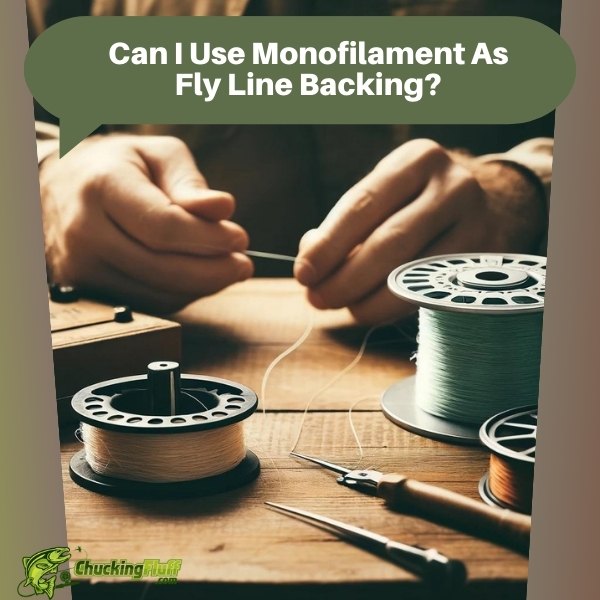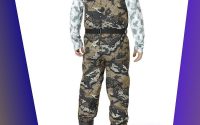| Disclosure: Just to be open and honest the buttons and links you click on in the website will in most cases take you to another website where you can purchase the products I am reviewing. As an Amazon Associate I earn from qualifying purchases. |
Can I Use Monofilament As Fly Line Backing?

When it comes to the world of fly fishing, the details matter. From the weight of your fly rod to the type of flies you use, each component plays a crucial role in your angling experience. One often overlooked aspect is the choice of fly line backing. Traditionally, Dacron or braided line has been the go-to choice for backing material. However, anglers often wonder: Can I use monofilament as fly line backing? Let’s delve into this question and explore the pros and cons of using monofilament as fly line backing.
Quick Post Navigation
- Introduction to Fly Fishing Backing
- Understanding Monofilament Fishing Line
- Benefits of Using Monofilament as Fly Line Backing
- Drawbacks of Using Monofilament as Fly Line Backing
- Alternatives to Monofilament Backing
- Tips for Using Monofilament as Fly Line Backing
- Conclusion
- FAQs
- “Check out some of our other Buying Guides”
Introduction to Fly Fishing Backing
Before we dive into the specifics of monofilament backing, let’s understand the purpose of fly line backing. Backing serves as a foundation for your fly line, adding length to your reel’s capacity and providing an additional layer of strength and support. In essence, it acts as an insurance policy, especially when battling large, powerful fish that may strip your fly line.
Understanding Monofilament Fishing Line
Monofilament fishing line is a single strand of synthetic material, typically made from nylon. It’s known for its flexibility, buoyancy, and abrasion resistance. Anglers commonly use monofilament line for various fishing applications, including spinning, baitcasting, and trolling.
Benefits of Using Monofilament as Fly Line Backing
Increased Line Capacity
One of the primary advantages of using monofilament as fly line backing is its ability to increase line capacity. Monofilament is thinner in diameter compared to Dacron, allowing you to spool more line onto your reel without sacrificing strength.
Cost-Effectiveness
Monofilament backing is often more affordable than traditional Dacron backing, making it an attractive option for budget-conscious anglers. With monofilament, you can achieve ample line capacity without breaking the bank.
Versatility
Monofilament line is highly versatile and can be used in various fishing scenarios. Whether you’re targeting freshwater trout or saltwater species like bonefish or tarpon, monofilament backing can handle the challenge.
Drawbacks of Using Monofilament as Fly Line Backing
Stretch
Monofilament backing’s stretchiness can be a significant disadvantage, particularly when you’re battling a large fish or engaged in a prolonged fight. Unlike other types of backing, monofilament has a certain degree of elasticity, which means it can elongate under tension. This stretchiness can make it challenging to maintain control over the fish, as it reduces your ability to transmit precise movements from your rod to the fish. As a result, you may find it more difficult to steer the fish away from obstacles or to tire it out efficiently. Additionally, the stretch in monofilament backing can lead to a delayed response when setting the hook, potentially resulting in missed opportunities to secure your catch.
Visibility
Another drawback of monofilament backing is its increased visibility underwater. When submerged, monofilament line is more conspicuous compared to alternatives like Dacron backing. This heightened visibility can be a cause for concern, especially in clear water conditions where fish may be easily spooked by unnatural-looking lines. In such scenarios, wary fish may become hesitant to strike at your fly, or they may even actively avoid your presentation altogether. Anglers who prioritize stealth and camouflage in their approach may find that the visibility of monofilament backing detracts from their ability to effectively deceive fish into taking the bait.
Knot Slippage
The smooth surface texture of monofilament can make it susceptible to knot slippage if not tied correctly. Knot slippage occurs when the tension on the line causes the knots to loosen and eventually come undone. This poses a significant risk to the integrity of your connections, as a slipped knot can result in the loss of your fly line or, worse, the fish itself. To mitigate the risk of knot slippage, it’s crucial to use appropriate knot-tying techniques and to ensure that each knot is cinched down tightly. Additionally, periodically inspecting your knots for signs of wear or slippage can help prevent potential mishaps while on the water.
Alternatives to Monofilament Backing
While monofilament backing offers certain advantages, it’s essential to consider alternative options based on your fishing preferences and requirements. Braided Dacron, for example, provides minimal stretch and excellent knot strength, making it a popular choice among fly anglers.
Tips for Using Monofilament as Fly Line Backing
Proper Knots
When spooling monofilament backing onto your reel, ensure you use appropriate knots to secure the line. Popular options include the Arbor Knot or the Albright Knot for connecting backing to the fly line.
Line Capacity Considerations
Before opting for monofilament backing, consider the specific requirements of your fishing environment and target species. Ensure that the increased line capacity provided by monofilament is suitable for your needs.
Visibility Management
To mitigate the visibility of monofilament backing, consider adding a length of colored fly line backing or using a colored marker to camouflage the line’s appearance in the water.
Conclusion
While monofilament can serve as a viable option for fly line backing, it’s essential to weigh the pros and cons before making a decision. Consider factors such as line capacity, stretch, visibility, and knot strength to determine if monofilament is the right choice for your angling endeavors.
FAQs
Q) Is monofilament backing suitable for all types of fly fishing?
A) While monofilament backing can be used in various fly fishing scenarios, it’s essential to consider factors such as line capacity and visibility based on your specific fishing conditions and target species.
Q) How do I prevent knot slippage when using monofilament backing?
A) To prevent knot slippage, ensure you tie appropriate knots such as the Arbor Knot or Albright Knot and thoroughly cinch them down to secure the connection.
Q) Does monofilament backing affect casting performance?
A) Monofilament backing may affect casting performance due to its inherent stretchiness. However, with proper line management techniques, casting efficiency can be maintained.
Q) Can I use monofilament backing in saltwater environments?
A) Yes, monofilament backing can be used in saltwater environments, but it’s essential to rinse your gear thoroughly after each use to prevent corrosion and prolong the lifespan of your equipment.
Q) What are some alternatives to monofilament backing?
A) Alternatives to monofilament backing include braided Dacron, gel-spun polyethylene, and hybrid backing materials, each offering unique advantages and drawbacks.


